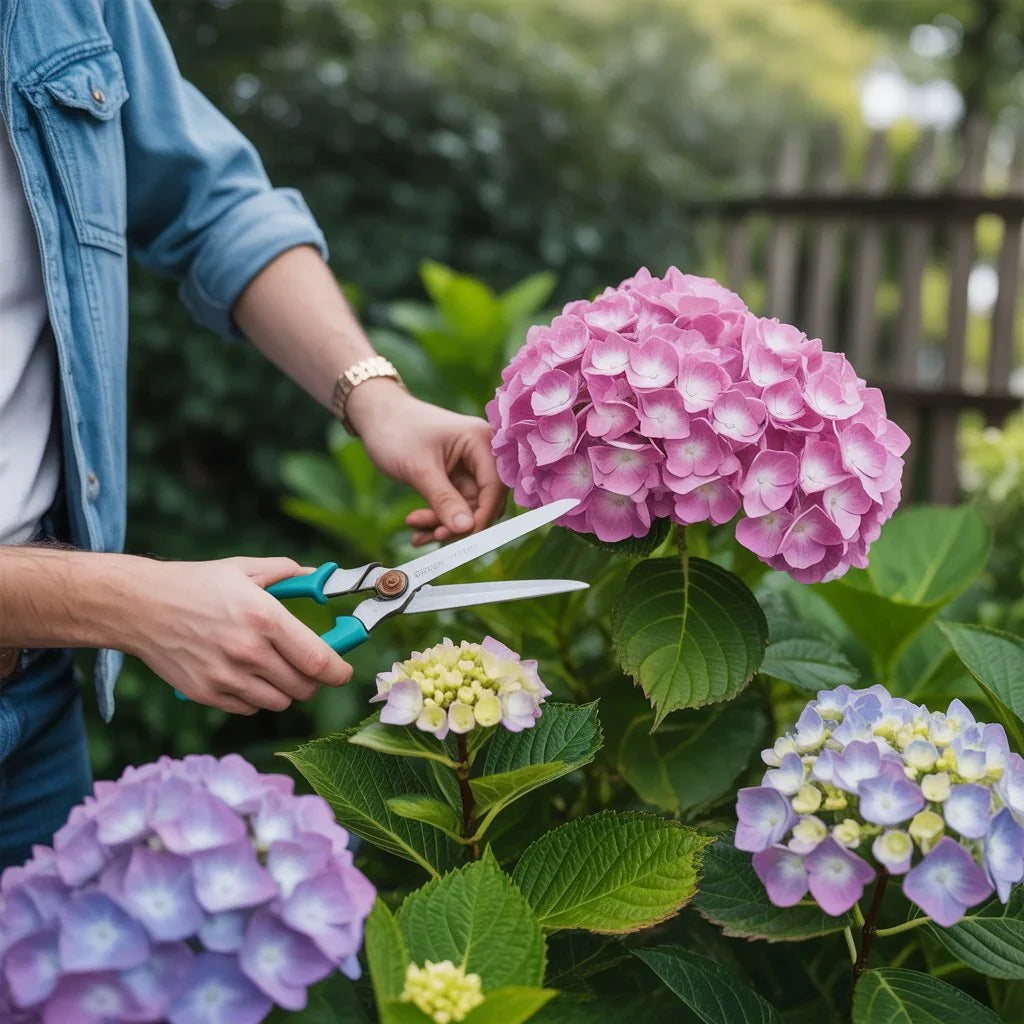
When and how to Prune Hydrangeas Without Killing Them
Share
Pruning hydrangeas can feel intimidating, especially in a city like New York where weather, timing, and space all play a role. But if you know exactly how to prune hydrangeas, you'll not only avoid harming your plants—you'll unlock the full potential of lush, showstopping blooms season after season.
This comprehensive NYC pruning guide will show you when to prune hydrangeas, how to trim for health and beauty, and how to avoid the most common mistakes that cost gardeners their blooms. Whether you're managing a container garden in Brooklyn or a shady patch on the Upper West Side, this guide is your seasonal roadmap.
How to Prune Hydrangeas Without Harming Them
Hydrangeas aren't one-size-fits-all when it comes to pruning. The way you prune depends on the type of hydrangea you're growing. Bigleaf, oakleaf, panicle, and smooth hydrangeas all bloom on different wood — and pruning at the wrong time could eliminate the next season's flowers.
Start by identifying your plant type. Bigleaf and oakleaf hydrangeas bloom on old wood, which means they should be pruned immediately after flowering. Panicle and smooth hydrangeas bloom on new wood and can be safely pruned in late winter or early spring before new growth begins.
When to Prune Hydrangeas in NYC
Timing matters more than anything. Here's when to prune depending on your hydrangea variety:
- Bigleaf & Oakleaf Hydrangeas: Prune in July or early August, just after blooming. Avoid fall pruning.
- Panicle Hydrangeas: Prune in late winter to early spring, typically February to March.
- Smooth Hydrangeas: Cut back hard in early spring for larger blooms.
When is it too late to cut back hydrangeas? If your hydrangea blooms on old wood, it's too late once buds begin to form in early fall. For new wood bloomers, you're generally safe until mid-spring.
How to Trim Hydrangeas for Shape and Size
Pruning isn't just about timing—it's about form. Here's how to trim hydrangeas while keeping their natural beauty:
- Use clean, sharp pruning shears to avoid disease
- Cut stems at a 45-degree angle just above a healthy bud or node
- Remove any dead, damaged, or crossing branches first
- Thin out the center of the plant for airflow and light
Want more blooms next year? Don’t over-prune—light shaping goes a long way.
How to Prune Hydrangeas in the Spring
If you're working with panicle or smooth hydrangeas, spring pruning gives you control over size and bloom strength. Cut back stems to 1/3 their height, or even down to the base if you're looking for big, bold blooms.
Avoid pruning bigleaf or oakleaf varieties in spring. You could accidentally remove last year's growth, which contains this season's flowers.
How to Prune Hydrangeas in the Fall
Fall pruning is risky in NYC’s variable climate. Avoid cutting back old wood bloomers in the fall, as this removes flower buds set during the summer.
Only trim in fall if you're removing dead stems or tidying the plant’s shape. For most pruning, wait until spring or prune immediately after summer bloom.
How to Prune Hydrangeas in the Winter
Winter pruning works well for hydrangeas that bloom on new wood. Panicle and smooth hydrangeas benefit from a hard cutback in February or March. Remove up to half the height to encourage sturdy, prolific growth.
Avoid winter pruning for hydrangeas that bloom on old wood. The buds are already set and highly vulnerable to damage.
How to Trim Back Hydrangeas Without Stressing Them
Consistency is more important than severity. Trim with a plan, never just for appearance. Always remove the three D’s first: dead, damaged, and diseased wood. Open up the center slightly to promote airflow.
Do you cut back hydrangeas every year? Not always. Some years require only light maintenance. Let the plant’s growth guide your cuts.
When to Cut Back Hydrangeas for Best Results
Cut back hydrangeas when the plant is dormant but before new growth begins. For old wood varieties, stick to post-bloom pruning. For new wood varieties, wait until late winter or very early spring.
Never prune blindly. Always look for swelling buds or old flower heads to guide your cuts. Cutting below a node can delay blooming or result in bare stems.
Can Hydrangeas Be Pruned Heavily?
Yes—but only certain types. Smooth and panicle hydrangeas can handle heavy pruning, and often benefit from it. Bigleaf and oakleaf types prefer light shaping. Over-pruning them may cause weak stems or no blooms at all.
If you’re unsure, start with light pruning and observe the plant’s response. You can always cut more, but you can’t put branches back.
Pruning Tips for NYC Gardeners
Urban gardening calls for precision. NYC's changing seasons, limited space, and reflected heat from buildings all influence hydrangea behavior.
- Use compact tools that fit tight spaces
- Shield freshly cut stems from wind exposure
- Water after pruning to ease plant stress
- Avoid fertilizing immediately after pruning—wait until new growth appears
Get the Tools, Get the Blooms
Pruning isn't guesswork—it's strategy. When done right, it sets the stage for rich, colorful blooms all season long. But the right tools make all the difference.
Get hydrangea-ready tools or book a seasonal bouquet refresh in Manhattan through Black Petals. Our NYC florists know the timing, techniques, and varieties that thrive in your borough.
Transform your garden or container space into a masterpiece—and never worry about missing a bloom again.
